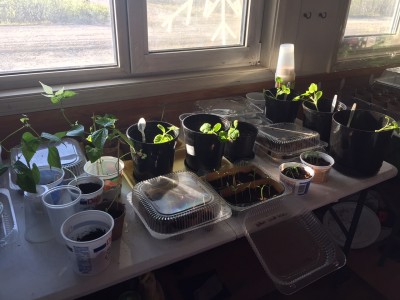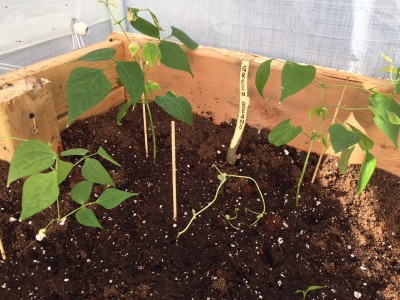In April, when the average temperature hovers around 20 above, and the snow glistens in the 12 hour sunlight, arctic gardeners like to start their seeds. Throughout the year, we wash out yogurt containers, sour cream and cottage cheese containers save egg cartons, paper towel tubes, and even those clear plastic takeout containers. We start seeds because the nearest greenhouse is 600 air miles away and we can’t afford to wait for the weather.
While the kids are ice fishing, my husband and I set up two folding tables next to the two best windows in the house, momentarily sacrificing the best sun for veggies we won’t even see for three or four months. We are genuinely overzealous in our planting every year: Carrots, Radish, Peppers, Jalapenos, Tomatoes, Broccoli, Cauliflower, Turnips, Beets, Lettuce, Cabbage, Strawberries, Beans, Peas, Sunflowers and Pumpkins. We plant fifteen times as much as we will ever need, because when all you see is snow, snow and more snow, the possibility of a little green plant coming up warms your heart faster than the wood stove in December. And on the joyous occasion that the pumpkins ever grow, you celebrate. In the snow.
This spring, the snow melted much faster than in other years, so our miniature amazon rainforest of baby plants was put into the greenhouse a little early. We always wait until the danger of frost is gone, but apparently when it’s 60 degrees for two weeks at the end of May it could possibly snow the next week. Unfortunately, the weather God was tricky and we had to supplement the natural heat from the sun with a 10 lb propane bottle usually saved for the chicken coop in my sisters yard. But, my plants don’t have feathers, so too bad Chickens!
Of the six or seven people who garden plants other than the natural berries and root vegetables we pick in the tundra, I am the least knowledgeable of the bunch. I want a hundred pounds of potatoes, and a hundred pounds of carrots, and twenty heads of cabbage, but usually I get enough carrots to last a week and potatoes good enough to eat once. My space is limited, but my ambition is not. We grow things in buckets, pallets, a reclaimed wood 10×2 (x3) raised bed, old boots, tires, boxes, dressers and more. Whatever is raised off the ground, and can be filled with soil works for us. Why? Because we live on rocks. Rocks, pebbles, and sand. Very good for drainage, pretty bum for plants. And our average wind speed just this month has been higher than normal. So, we plant in a greenhouse, or stick some plastic sheeting around the boxes. It’s all about survival up here.
 Since it’s the end of June, some of the more leggy plants have not survived the spring in the greenhouse, or the tires, or the outdoor planting boxes. But, we do have quite a few that are still alive and flourishing. The Zucchini looks great, the Cauliflower and Broccoli are wonderful. I even got a tomato plant to make some little green tomatoes so far (which is a first for me in the Arctic). I might even be able to enjoy a salad in a month or so.
Since it’s the end of June, some of the more leggy plants have not survived the spring in the greenhouse, or the tires, or the outdoor planting boxes. But, we do have quite a few that are still alive and flourishing. The Zucchini looks great, the Cauliflower and Broccoli are wonderful. I even got a tomato plant to make some little green tomatoes so far (which is a first for me in the Arctic). I might even be able to enjoy a salad in a month or so.
Gardening in the Arctic definitely takes a little more time to plan, and a little less time to grow, but the resulting fruits and vegetables are all packed full of nutrients, tart, and tasty. If you plan well, have lots of space inside your house, and can raise your garden bed, or provide for warmer soil, you’ll end up with great looking plants and even cooler plant markers!
P.S. It’s only the end of June, so none of my plants are remotely close to producing edibles, unless you count the lettuce! 🙂
About MaijaKatak
Twitter •


